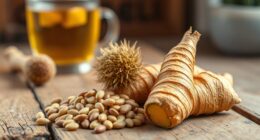Whole-plant remedies use entire parts of the plant, preserving all natural compounds for holistic healing. They offer a balanced blend of nutrients and phytochemicals that work together synergetically, often resulting in stronger, more effective results than extracts. By choosing whole plants, you retain the plant’s full medicinal profile with fewer additives. To deepen your understanding, exploring more about herbs, preparation methods, and safe use can help you confidently incorporate these natural medicines into your wellness routine.
Key Takeaways
- Whole-plant remedies preserve the full spectrum of nutrients and phytochemicals for holistic healing and synergistic effects.
- Using entire plants minimizes additives, ensuring purer, more balanced herbal remedies.
- Proper preparation methods like infusions, decoctions, and tinctures optimize herbal efficacy and safety.
- Sourcing high-quality, organic, and correctly identified plants is essential for safe and effective herbal medicine.
- Engaging with herbal communities enhances knowledge, safety practices, and confidence in using whole-plant remedies.
What Are Whole-Plant Remedies?
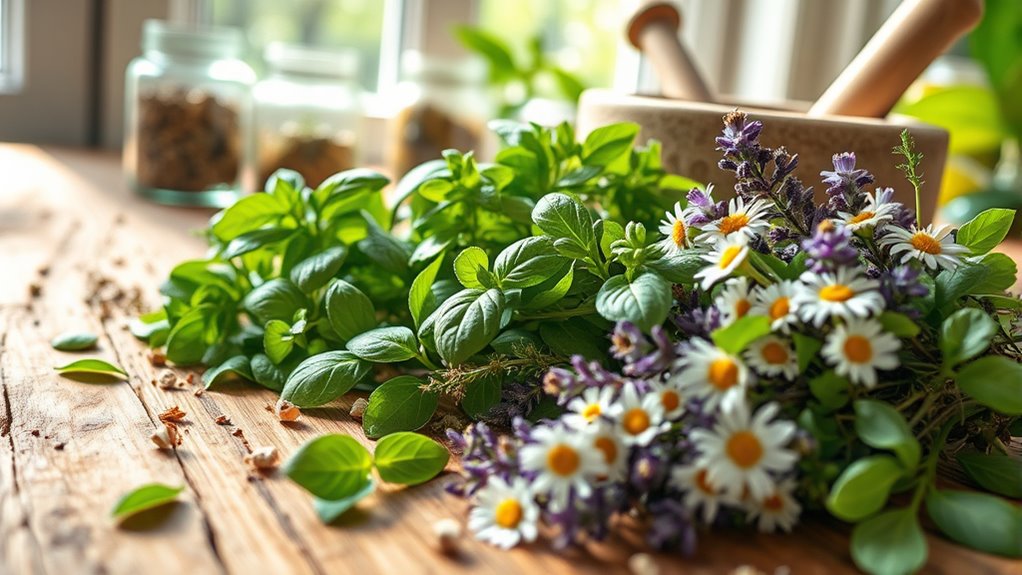
Have you ever wondered what makes whole-plant remedies different from other herbal treatments? The key lies in plant extraction and herbal cultivation. Whole-plant remedies use the entire plant or its significant parts, preserving all natural compounds that work together for healing. During plant extraction, the process captures the plant’s full spectrum of nutrients, phytochemicals, and active ingredients, unlike isolated extracts. Herbal cultivation ensures plants are grown sustainably and organically, maintaining their potency. This approach allows you to benefit from the plant’s holistic properties, supporting your health more naturally. Additionally, herbal composition is crucial to ensure the responsible development and use of herbal products, safeguarding consumers and preserving traditional knowledge. Understanding plant synergy can help you appreciate how the combined effects of all plant compounds contribute to overall health benefits. Recognizing the importance of plant cultivation methods can also enhance your trust in herbal remedies, ensuring they are produced with care and respect for nature. Moreover, embracing sustainable farming practices can help preserve biodiversity and ensure the long-term availability of medicinal plants. Whole-plant remedies emphasize harmony, using the plant’s complete profile rather than just a single compound, making them a popular choice for those seeking a balanced, authentic herbal experience.
The History and Tradition of Herbal Healing

Herbal healing has been an integral part of human culture for thousands of years, shaping medical practices across civilizations. From ancient Egypt to Traditional Chinese Medicine, people relied on medicinal plant origins to treat ailments. Over time, the herbal tradition evolution reflects how societies preserved and adapted these remedies. This history shows that herbs weren’t just medicine—they were woven into cultural rituals and spiritual practices. Understanding this background helps you appreciate the depth of herbal healing. Here’s a quick look at some key points:
| Civilization | Notable Herbal Practice | Key Contribution |
|---|---|---|
| Egypt | Papyrus Texts | Documented medicinal plants |
| China | Herbal Formulas | Foundation of Traditional Chinese Medicine |
| Greece | Hippocratic Texts | Emphasized natural remedies |
| India | Ayurveda | Holistic herbal healing |
Your journey into herbal medicine connects with centuries of tradition, including the importance of plant-based treatments in various cultures. Recognizing the historical significance of herbs enhances your understanding of their enduring value in healing practices. Additionally, the development of herbal pharmacology has contributed to modern medicinal approaches, bridging ancient wisdom with contemporary science.
Furthermore, ongoing research continues to validate many traditional uses, demonstrating how scientific studies support the efficacy of herbal remedies.
Common Types of Herbal Preparations

Curious about how herbal remedies are prepared and used? There are several common types to contemplate. First, herbal tinctures are concentrated extracts made by soaking herbs in alcohol or glycerin, capturing their medicinal properties. Imagine a deep amber liquid, ready to be added to tea or taken directly. Second, herbal infusions involve steeping herbs in hot water, creating flavorful teas that deliver gentle, soothing effects. Visualize a steaming cup of chamomile or mint tea. Third, you might encounter herbal decoctions, where tougher plant parts like roots are simmered slowly to extract their benefits. These preparations are straightforward ways to incorporate whole plants into your routine, helping you harness their healing power naturally and effectively. Additionally, understanding the herbal preparation methods can be useful for optimizing the use of herbal remedies. Moreover, exploring the cultural impact of traditional herbal practices can deepen your appreciation for these natural remedies. For example, awareness of herbal safety is essential to prevent adverse reactions and ensure effective use.
Benefits of Using Whole Plants Over Extracts

Using whole plants gives you access to full spectrum nutrients that extracts might miss. The natural combination of compounds works together, creating stronger effects through synergy. Plus, you’ll need fewer additives, making whole plants a purer, more balanced choice. Incorporating herbal remedies like infused oils can enhance the therapeutic benefits further. Additionally, consuming the entire plant preserves its entire phytochemical profile, which can be crucial for achieving the desired medicinal effects. Recognizing the importance of plant diversity ensures you receive the full range of beneficial compounds present in whole-plant preparations. Emphasizing sustainable cultivation practices can also support the health and potency of medicinal herbs over time. The use of specialized planters can support healthy growth and maximize the medicinal properties of herbs.
Full Spectrum Nutrients
Full spectrum nutrients, which come from whole plants, offer a more complete array of benefits compared to extracts. By preserving the full range of plant compounds, you support plant synergy, where nutrients work together for maximum effect. This approach maintains nutrient preservation, ensuring you receive all the natural elements as intended. When using whole plants, you’re more likely to access a diverse array of vitamins, minerals, and phytochemicals that work in harmony. Proper preservation of nutrients ensures that the full profile of beneficial compounds remains intact during preparation and use. Utilizing whole-plant remedies can enhance the overall therapeutic effect by maintaining the natural plant synergy of plant constituents. Additionally, growing your own herbs and seeds at home allows for better control over organic cultivation practices, further enhancing nutrient integrity.
Synergistic Effects Enhance
Because whole plants contain a complex mix of compounds, they create synergistic effects that amplify their health benefits. This plant synergy results from herbal interactions where different constituents work together, enhancing absorption and efficacy. When you use the whole plant, you’re not just getting isolated active ingredients but a harmonious blend that boosts overall effectiveness. These effects make herbal remedies more balanced and less likely to cause side effects. For example, some compounds may modulate others, reducing potential toxicity. Recognizing this, many herbalists prefer whole plants over extracts for their natural synergy. Additionally, the divorce statistics highlight the importance of understanding complex processes, much like appreciating the multifaceted benefits of whole-plant remedies.
Fewer Additives Needed
Selecting whole plants often means you can avoid adding unnecessary ingredients or fillers found in many herbal extracts. When you use the whole plant, you benefit from herbal synergy, where the diverse compounds work together more effectively. This plant diversity guarantees you’re getting a balanced mix of nutrients and active ingredients without synthetic additives. Imagine:
- A vibrant mix of roots, leaves, and stems working in harmony.
- Natural compounds supporting each other for better absorption.
- Minimal processing, preserving the plant’s natural complexity.
How to Identify and Source Quality Herbs
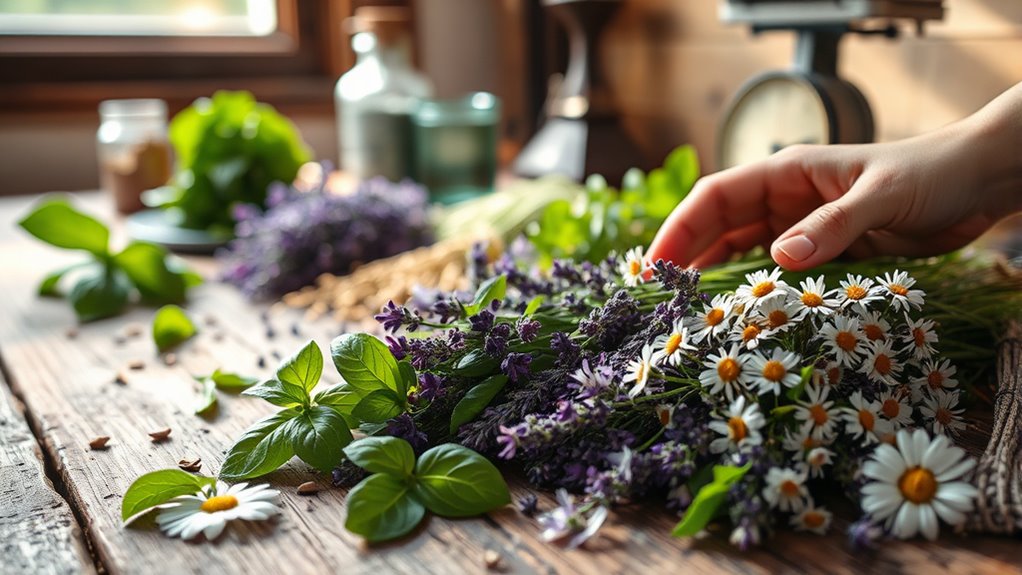
To guarantee you’re using effective herbs, it’s essential to learn how to identify and source high-quality options. Start by observing plant traits like color, scent, and texture. Always choose herbs that look fresh and vibrant, avoiding dull or wilted plants. Look for herbs with organic certification, ensuring they’re grown without harmful chemicals, which boosts potency and safety. When herbal harvesting, pick herbs at their peak maturity for maximum medicinal benefits. Sourcing from reputable suppliers or local farmers who follow organic practices helps ensure quality. Use this table as a quick reference:
| Aspect | What to Look For | Why It Matters |
|---|---|---|
| Freshness | Bright color, firm texture | Potency and flavor |
| Organic certification | Certified organic labels | No harmful chemicals |
| Harvesting time | Peak maturity during harvest | Maximum medicinal properties |
Basic Safety Tips for Herbal Use

While herbal remedies can be beneficial, it’s vital to prioritize safety to prevent adverse reactions. Start by mastering plant identification to make sure you’re using the correct herbs and avoid dangerous look-alikes. Always check for allergy awareness, as some herbs can trigger reactions, even if you’ve used them before.
Here are key safety tips to keep in mind:
- Confirm the plant’s identity through reliable sources before use.
- Test a small amount first to check for allergies or sensitivities.
- Keep herbal remedies out of reach of children and pets to avoid accidental ingestion.
Incorporating Herbs Into Daily Wellness Routines
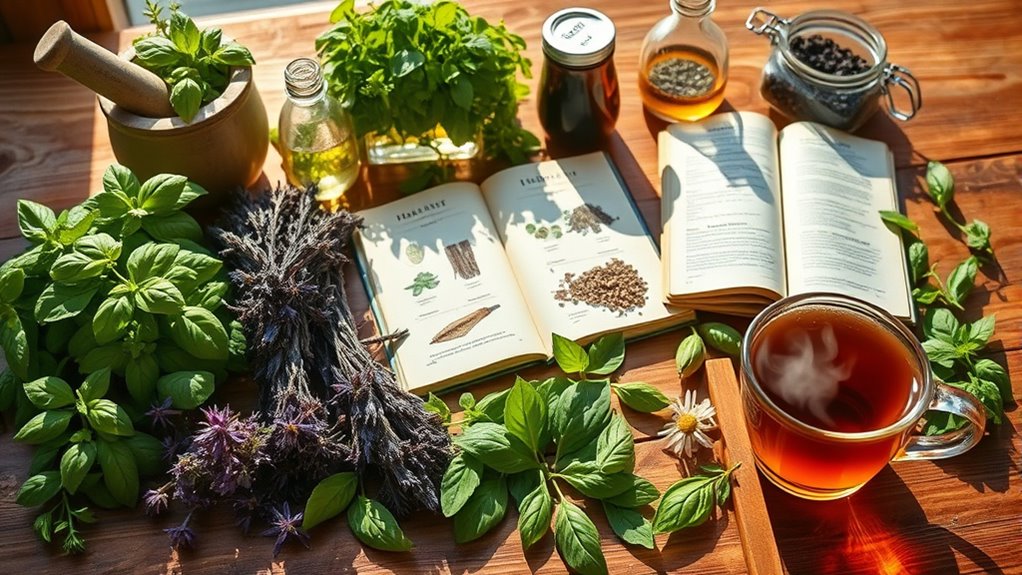
Start your day with a warm cup of morning herbal tea to boost your energy and focus. In the evening, practice relaxation techniques like gentle stretches or meditation to wind down with calming herbs. Incorporating these simple routines helps you enjoy the benefits of herbs seamlessly into your daily life.
Morning Herbal Teas
Incorporating herbal teas into your morning routine can boost your energy and set a positive tone for the day. Start your morning with carefully chosen tea infusions or herbal blends that awaken your senses and support your well-being. Visualize:
- A steaming cup of chamomile and ginger tea, aroma filling the room.
- Handfuls of vibrant green herbs like mint and basil steeping in hot water.
- A cozy moment savoring a citrus-tinged hibiscus infusion, bright and invigorating.
These herbal blends not only hydrate you but also provide antioxidants and calming effects. By integrating these into your mornings, you create a simple, powerful ritual that promotes vitality and mindfulness. Experiment with different herbs to find your perfect blend for an energized start.
Evening Relaxation Practices
As your day winds down, shifting from energizing herbal teas to calming herbal routines can help you unwind and prepare for restful sleep. Incorporate calming rituals like gentle stretches or a warm herbal-infused bath to signal your body that it’s time to relax. Practice mindful breathing, focusing on slow, deep inhales and exhales to calm your nervous system. You might choose herbs like chamomile, lavender, or valerian in teas or aromatherapy to enhance your relaxation. Establishing a consistent evening routine creates a peaceful progression from day to night. By integrating these calming rituals and mindful breathing, you set a foundation for more restful sleep and a balanced, holistic approach to your wellness routine.
Understanding Herbal Potency and Dosage

Understanding herbal potency and dosage is vital to using herbs safely and effectively. Herbal potency varies based on the plant’s strength and preparation method, so knowing how much to take is essential. Following proper dosage guidelines helps prevent adverse effects and guarantees you get the benefits. Imagine:
Knowing the right herbal dose ensures safe, effective use and maximum benefits.
- Measuring powdered herbs with a teaspoon, visualizing the exact amount.
- Brewing a perfect cup of tea, knowing the right steeping time to maximize potency.
- Using a dropper to carefully add tincture, guaranteeing accurate dosing.
Tips for Making Your Own Herbal Remedies at Home
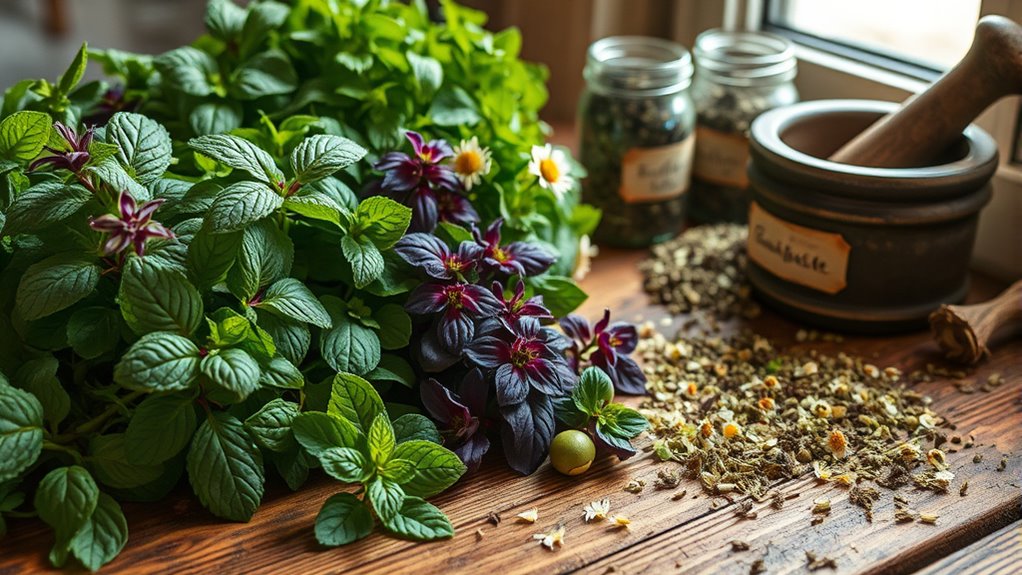
Making your own herbal remedies at home can be a rewarding way to customize your wellness routine, but it’s important to start with proper techniques. Begin with herbal cultivation by choosing healthy, organic plants and understanding the best growing conditions. Harvest herbs at their peak potency for the strongest medicinal properties. When preparing remedies, dry herbs thoroughly and store them in airtight containers away from light, heat, and moisture to preserve their potency. Proper herbal storage is essential to prevent spoilage and maintain effectiveness over time. Label your containers clearly with the herb name and date. Keep your herbal supplies organized and accessible, so you can easily incorporate fresh or dried herbs into your remedies. Following these tips helps ensure your homemade remedies remain potent and safe.
Resources for Further Learning and Exploration
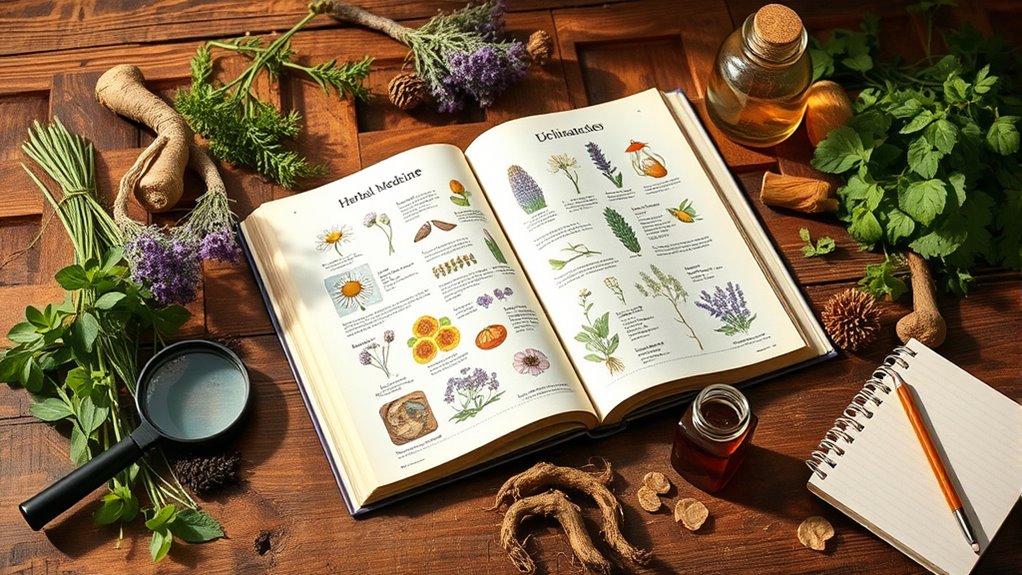
To expand your herbal knowledge, consider exploring recommended books and articles that cover a wide range of herbal practices. Joining online herbal communities allows you to connect with others, ask questions, and share experiences. These resources can deepen your understanding and support your herbal journey.
Recommended Reading Materials
Are you enthusiastic to expand your knowledge of herbal medicine? Diving into the right reading materials can deepen your understanding and dispel common herbal medicine myths. To start, consider these resources:
- A exhaustive guide on herbal gardening that shows you how to grow your own medicinal herbs, making herbal remedies more accessible.
- Books addressing herbal medicine myths, helping you distinguish fact from fiction and build confidence in natural remedies.
- Expert-authored manuals that explore whole‑plant remedies, offering practical advice and scientific insights.
These materials will help you explore the fundamentals of herbal gardening and enhance your understanding of herbal medicine myths, empowering you to make informed decisions on your herbal journey.
Online Herbal Communities
Ever wondered where to find like-minded herbal enthusiasts and experts to deepen your knowledge? Online herbal communities are fantastic resources for this. Joining an herbal community or participating in online forums allows you to connect with experienced herbalists and fellow beginners alike. These platforms offer a space to ask questions, share experiences, and learn about whole-plant remedies from diverse perspectives. Many forums feature discussions on herbal preparations, sourcing, and safety tips, making them invaluable for your journey. By engaging regularly, you’ll gain practical insights and build confidence in your herbal practice. Whether on social media groups, dedicated herbal forums, or community websites, these online spaces foster support, learning, and inspiration as you explore herbal medicine.
Frequently Asked Questions
Are There Any Risks or Side Effects Associated With Whole-Plant Remedies?
You should be aware that whole‑plant remedies can have herbal safety concerns and side effects. While generally gentle, some plants may cause allergic reactions or interact with medications. Always research the specific herbs you’re using and monitor your body’s response. It’s smart to consult with a healthcare professional, especially if you’re pregnant, nursing, or taking other medications, to guarantee safe and effective use of herbal remedies.
Can Herbal Remedies Interact With Prescription Medications?
Think of herbal remedies as a lively dance partner; they can sometimes step on your prescription’s toes. Yes, they can interact with your medications, leading to unexpected effects. You should be cautious about drug interactions and be mindful of dosage considerations. Always talk to your healthcare provider before combining herbal remedies with prescription drugs, ensuring your dance stays smooth and safe.
How Long Does It Take to See Results From Herbal Treatments?
You might start noticing results from herbal treatments within a few days to several weeks, but it really depends on your individual response rates and the condition you’re addressing. Some people experience faster improvements, while others need more time. It’s important to be patient and consistent with your herbal remedies, as understanding your body’s timeline expectations helps you gauge progress and avoid unnecessary worry.
Are There Specific Herbs Suitable for Children or Pregnant Women?
You should choose child-safe herbs and pregnancy-friendly remedies carefully, always consulting a healthcare professional first. Herbs like chamomile, ginger, and fennel are generally safe for children and pregnant women when used appropriately. Avoid potent herbs like sage or rosemary during pregnancy. Always follow dosage guidelines, and check for any potential allergies or interactions. Prioritizing safety helps make certain herbal treatments support health without risks.
How Can I Tell if an Herbal Product Is Properly Certified or Authentic?
Think of herbal products as a treasure chest—you want to guarantee the gems inside are genuine. To verify authenticity, check for clear herbal certification from trusted sources, and look for labels that detail the botanical ingredients and processing methods. Authentic products often have batch numbers and third-party verification seals. Doing this helps you confidently choose herbal remedies, knowing they meet safety and quality standards, guiding you on a safe herbal journey.
Conclusion
Embracing whole-plant remedies connects you to centuries of herbal wisdom. Did you know that herbal medicine is estimated to be used by over 80% of the world’s population for primary healthcare? By learning to identify quality herbs and making your own remedies, you empower yourself to support your health naturally. Start small, stay curious, and enjoy the journey into holistic healing—your body will thank you for it.









